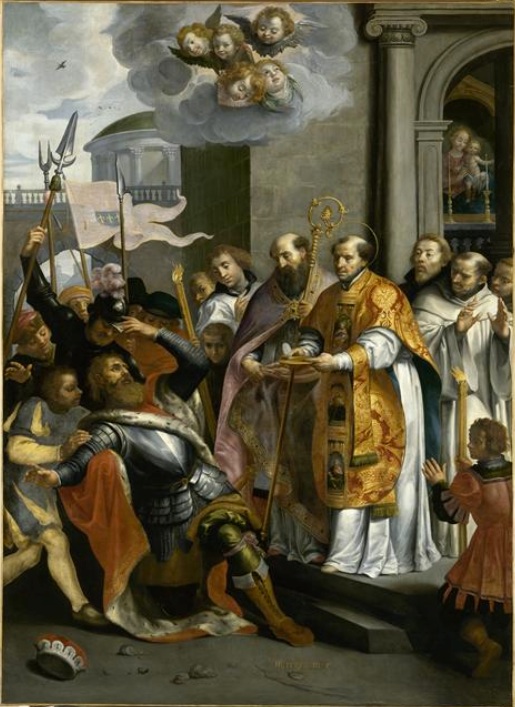MIRACLES
The Vita Prima, Bernard's earliest biography, claims a great number of miracles for the saint, including exorcisms and miraculous cures. The exorcisms are sometimes portrayed (example) but I have not encountered any images of the miraculous cures.VISIONS
Only a few visions are mentioned in the early vitae, but those few were pictured again and again in the art. In one common type, the Virgin Mary appears to Bernard while he is writing at his desk, often in an open-air setting (example).1 This type may have inspired the portrait of Bernard contemplating the Virgin from the bottom register of a modern stained glass window in Munich.In another vision image, Jesus comes from the Cross to embrace him (example).2 The most unusual vision has the Virgin Mary sharing with Bernard some of the milk from her breast (example).3
CONFRONTING DUKE WILLIAM OF AQUITAINE
The vitae claim that Duke William (most likely William IX of Aquitaine) was a "schismatic" who reconciled with the Church after Bernard confronted him outside a church in Parthenay, as in the third picture at right. Nearly identical paintings of the confrontation can be found at a number of sites.4PORTRAITS
In portraits Bernard is tonsured and wears the white habit of the Cistercians, sometimes with the hood up, as in the first picture at right. Occasionally a white dog is used as his attribute; one can be seen in the exorcism picture mentioned above. More commonly, the creature with him will be a small demon, referring to his many exorcisms, as in the first picture at right. Other images express his devotion to the Passion of Christ by having him hold a crucifix or cross in his arms, often with a spear and/or a sponge on a pole, as in this example and the second picture at right.As a founder of an abbey Bernard is sometimes portrayed with a crozier, as in the third picture at right. In one altarpiece he also wears a mitre, an honor allowed only to a few important abbots.
Prepared in 2015 by Richard Stracke, Emeritus Professor of English, Augusta University.
HOME PAGE

St. Bernard in his Cistercian habit, with a chained demon at his bare feet. (See the description page.)

St. Bernard is often portrayed with these symbols of the Passion of Christ (See description page.)

Marten Pepijn, St. Bernard and the Duke of Aquitaine (See the description page.)
ATTRIBUTES
- Small demon
- Dog
- Crucifix or cross
- Spear or pole with sponge
MORE IMAGES
- 1320-25: St. Bernard appears among the attendant saints in Jacopo del Casentino's Madonna and Child Enthroned.
- 1390s: A portrait of St. John that accords him both a mitre and a crozier is included in the right wing of Cenni di Francesco's Coronation of the Virgin Altarpiece.
- Circa 1500: An image painted on glass of St. Bernard with a book and crozier but no specific attributes.
- 1607: Worshipping Mary and the Christ Child in Annibale Carracci's Madonna and Child with Saints.
- 18th century: Statue on the main altarpiece at St. Francis Xavier, Cáceres, Spain.
DATES
- Feast day: August 20
- Lived 1090-1153
NAMES
- Clairvaux was a town in north-eastern France. The abbey that Bernard established there is now a ruin, and the town is part of the commune of Ville-sous-la-Ferté.
BIOGRAPHY
- Golden Legend #120: html or pdf
- Bernard's vita in The Roman Breviary:, III, 842-43
- The article for Bernard in the Acta Sanctorum (August vol. 4, 101-368) includes an extensive biographical essay and several vitae, including the earliest one, the Vita Prima.
- Webb, St. Bernard of Clairvaux, is an English translation of the Vita Prima.
- Carolus de Smedt et al., "Miraculum S. Bernardi, Auctore Herberto," Analecta Bollandiana, XX (1901), 71-80.
NOTES
1 Paintings of this type must surely have their origin in some text, but nothing of the sort is to be found in the extensive material presented in the Acta Sanctorum (August vol. 4, 101-368). Visions of the Virgin Mary do figure in the literature, one occurring as he was entering a town and saluted a statue of her (Acta Sanctorum, August vol. 4, 206-208) and another when he was on his deathbed (Ibid. 220; Webb 75). And we find in the Golden Legend that the saint "said that all that he had learned of holy scripture he had learned it in woods, in fields, most by meditation and praying" (#120, Ryan 101). But so far I have found nothing about Mary visiting the saint at his desk.
2 This vision is discussed in chapter 47 of the Acta Sanctorum's biographical essay (August vol. 4, 210).
3 See chapter 46 in the Acta Sanctorum's biographical essay (Ibid., 206-208).
4 Acta Sanctorum (Ibid., 153-54 and 286-89), Golden Legend (Caxton #120, Ryan 106), Webb 89-93.